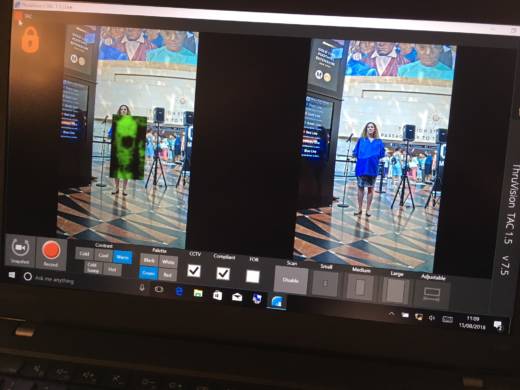"We're looking specifically for weapons that have the ability to cause a mass-casualty event," Wiggins said. "We're looking for explosive vests, we're looking for assault rifles. We're not necessarily looking for smaller weapons that don't have the ability to inflict mass casualties."
(Some further details on the technology via L.A. Metro:
Following a series of tests over the last year of TSA-vetted and approved security technologies at its stations, Metro has purchased several Thruvision TAC-TS4 portable terahertz millimeter wave passenger screening devices. The units can be placed at locations throughout the Metro system and are equipped with software that quickly and unobtrusively screens individuals for concealed threats. The units can identify both metallic and non-metallic objects.
The devices identify objects that block the naturally-occurring waves produced by a person’s body. When an object is hidden in clothing or strapped to a person, these waves are blocked and detected by the system’s software. The software generates generic avatars and creates either a black spot on the area of the body where the item is concealed or overlays a color indicator. The technology does not emit radiation of any kind and no anatomical details are displayed. The device allows law enforcement agents and Metro Security to screen rail and bus patrons without disrupting foot traffic and to take decisive, pre-emptive action if suspicious items are found.)
In addition to the Thruvision scanners, the agency is also planning to purchase other body scanners — which resemble white television cameras on tripods — that have the ability to move around and target specific people and angles, Wiggins said.
"We really want to be effective and we need the ability to have a fixed field of view, but we also need to be able to move that field of view as necessary," Wiggins said. "Deploying these technologies together gives us that accuracy and minimizes any delays."
Wiggins would not say how many of the machines were being purchased, but said they would be rolled out in subway stations in the "coming months." Employees and police officers first have to be trained on how to use the equipment.
Signs will be posted at stations warning passengers they are subject to body scanner screening. The screening process is voluntary, Wiggins said, but customers who choose not be screened won't be able to ride on the subway.
But some passengers saw the screening as an added layer of security.
"I guess it is a good, precautionary thing," Andrea Kirsh said, a 22-year-old student from Corvallis, Oregon, who was traveling through Los Angeles' Union Station on Tuesday. "It makes me feel safe. As a civilian I think we often don't know what to look for or what we would be looking for."
Passengers who rode down an escalator to ride the Metro Red Line at Union Station in Los Angeles on Tuesday were screened as Pekoske and other officials looked on. But after the news conference and media demonstration, officials packed up the equipment and carted it off.
The TSA tested body scanners in New York's Penn Station in February and has also conducted tests at Union Station in Washington, D.C., and at a New Jersey Transit station during the 2014 Super Bowl.
Metro has previously tested several different types of body scanners, including airport-style screening systems where passengers walk through a scanner. The pilot program was meant to evaluate the accuracy and capacity of the portable machines.
Weekday ridership for L.A. Metro's five rail lines averaged about 340,000 passengers in July.

